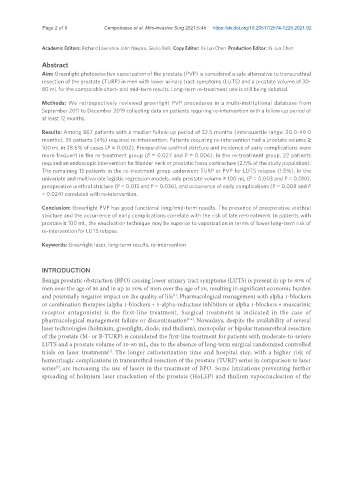Page 474 - Read Online
P. 474
Page 2 of 9 Campobasso et al. Mini-invasive Surg 2021;5:45 https://dx.doi.org/10.20517/2574-1225.2021.92
Academic Editors: Richard Lawrence John Naspro, Giulio Belli Copy Editor: Xi-Jun Chen Production Editor: Xi-Jun Chen
Abstract
Aim: Greenlight photoselective vaporization of the prostate (PVP) is considered a safe alternative to transurethral
resection of the prostate (TURP) in men with lower urinary tract symptoms (LUTS) and a prostate volume of 30-
80 mL for the comparable short- and mid-term results. Long-term re-treatment rate is still being debated.
Methods: We retrospectively reviewed greenlight PVP procedures in a multi-institutional database from
September 2011 to December 2019 collecting data on patients requiring re-intervention with a follow-up period of
at least 12 months.
Results: Among 867 patients with a median follow-up period of 32.5 months (interquartile range: 20.0-49.0
months), 35 patients (4%) required re-intervention. Patients requiring re-intervention had a prostate volume ≥
100 mL in 28.6% of cases (P = 0.002). Preoperative urethral stricture and incidence of early complications were
more frequent in the re-treatment group (P = 0.027 and P = 0.006). In the re-treatment group, 22 patients
required an endoscopic intervention for bladder neck or prostatic fossa contracture (2.5% of the study population).
The remaining 13 patients in the re-treatment group underwent TURP or PVP for LUTS relapse (1.5%). In the
univariate and multivariate logistic regression models, only prostate volume ≥ 100 mL (P = 0.003 and P = 0.010),
preoperative urethral stricture (P = 0.013 and P = 0.036), and occurrence of early complications (P = 0.008 and P
= 0.024) correlated with re-intervention.
Conclusion: Greenlight PVP has good functional long/mid-term results. The presence of preoperative urethral
stricture and the occurrence of early complications correlate with the risk of late re-treatment. In patients with
prostate ≥ 100 mL, the enucleation technique may be superior to vaporization in terms of lower long-term risk of
re-intervention for LUTS relapse.
Keywords: Greenlight laser, long-term results, re-intervention
INTRODUCTION
Benign prostatic obstruction (BPO) causing lower urinary tract symptoms (LUTS) is present in up to 80% of
men over the age of 80 and in up to 50% of men over the age of 50, resulting in significant economic burden
and potentially negative impact on the quality of life . Pharmacological management with alpha 1-blockers
[1]
or combination therapies (alpha 1-blockers + 5-alpha-reductase inhibitors or alpha 1-blockers + muscarinic
receptor antagonists) is the first-line treatment. Surgical treatment is indicated in the case of
[2-4]
pharmacological management failure or discontinuation . Nowadays, despite the availability of several
laser technologies (holmium, greenlight, diode, and thulium), monopolar or bipolar transurethral resection
of the prostate (M- or B-TURP) is considered the first-line treatment for patients with moderate-to-severe
LUTS and a prostate volume of 30-80 mL, due to the absence of long-term surgical randomized controlled
[2]
trials on laser treatments . The longer catheterization time and hospital stay, with a higher risk of
hemorrhagic complications in transurethral resection of the prostate (TURP) series in comparison to laser
series , are increasing the use of lasers in the treatment of BPO. Some limitations preventing further
[5]
spreading of holmium laser enucleation of the prostate (HoLEP) and thulium vapoenucleation of the

